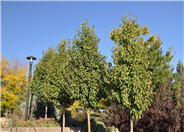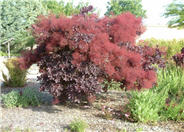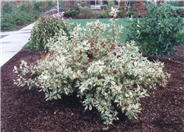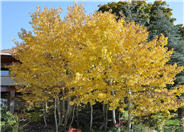
Common name:Chanticleer Flowering Pear
Botanical name:Pyrus calleryana 'Chanticleer'
‘Chanticleer’ is considered to be one of the best of the flowering pear cultivars currently available in commerce. It is a tight, narrow, pyramidal, thornless ornamental pear tree that typically grows 25 to 35 feet tall and 15 feet wide. Some specimens appear almost columnar in habit. Five-petaled, creamy white flowers in dense clusters appear in profusion in early spring. Oval, glossy dark green leaves have slightly toothed margins, and fairly dance in the breeze due to long petioles. Leaves turn attractive reddish-purple in fall. Useful in small spaces, patios, formal plantings, and as a living fence.

Common name:Purple Smoketree
Botanical name:Cotinus coggygria 'Purpureus'
Purple Smoketree is a deciduous shrub with a multi-stemmed, upright habit, growing about 12 to 15 feet tall and wide. Can be pruned to be a small tree. Leaves emerge a deep maroon purple and fade to dark green; fall color is orange to purple. Panicles of wispy dark pink appear in the summer after spring flowering, creating a billowing, soft effect.

Common name:Variegated Dogwood
Botanical name:Cornus alba 'Elegantissima'
This dogwood has the same lovely red wood that is a standout in the winter garden, but with grey-green leaves with irregular creamy-white margins that gives it a luminous look. It grows about 6 to 8 feet tall, and forms a thicket of blood-red stems. White spring flowers form in clusters, followed by blue berries enjoyed by birds. Partners well with viburnums, hydrangeas, and snowberry. Use in shrub or foundation borders, or as an informal hedge.

Common name:Quaking Aspen
Botanical name:Populus tremuloides
Though iconic to the Rocky Mountains, Aspen aren't well suited to our urban and valley landscapes. They resent the summer heat and the lack of snow, and as such are prone to a host of disease and pest issues. And if that's not enough, their tendency to sucker can create a maintenance nightmare. Consider instead Serviceberry or Manchurian Ash for a similar appearance.
| Designer: Ward and Child | WC Neighbor 10 |
Photographer: GardenSoft |
Water Saving Tip:
Change spray sprinklers to low-flow bubbler or drip systems. Shrubs and trees are ideal candidates for this type of irrigation because the water is applied directly to the root zones.
